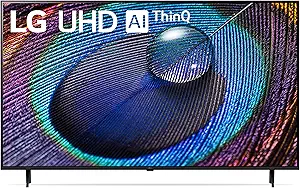LG and Hisense are two prominent brands in the television industry, each offering a range of models with varying features and technologies. LG, a South Korean company, is renowned for its OLED and NanoCell TVs that employ the latest technologies such as AI ThinQ, Dolby Vision IQ, and Dolby Atmos for an immersive viewing and listening experience. On the other hand, Hisense, a Chinese brand, is known for its ULED and Laser TVs that utilize technologies like Quantum Dot, Full Array Local Dimming, and Dolby Atmos. In terms of picture quality, LG's OLED TVs are lauded for their perfect blacks and infinite contrast ratio, which result in exceptional picture quality. However, they are relatively expensive. LG's NanoCell TVs, while more affordable, still offer excellent picture quality and vibrant colors, thanks to the NanoCell technology. On the other hand, Hisense's ULED TVs deliver impressive picture quality with deep blacks and vibrant colors, owing to the Quantum Dot and Full Array Local Dimming technologies. Hisense's Laser TVs, which are short-throw projectors, provide a cinema-like experience at home. However, they require a dark room for the best performance. Both brands offer smart TVs with voice control, but LG's AI ThinQ technology provides more advanced voice control features.
Key Features Comparison
Picture Quality
Top-Rated Picture Quality Brands
LG TVs are celebrated for their exceptional visual performance, largely attributed to their utilization of cutting-edge OLED (Organic Light Emitting Diodes) technology. OLED panels deliver unparalleled color accuracy, deeper blacks, and a broader viewing angle compared to conventional LED TVs. Furthermore, LG's OLED TVs support various HDR formats such as HDR10, Dolby Vision, and HLG HDR, enhancing the dynamic range and color gamut of the content. However, the adoption of OLED technology comes with a premium price tag, potentially placing LG TVs beyond the budget of some consumers. Conversely, Hisense TVs, particularly their ULED range, offer commendable picture quality. Hisense's proprietary ULED technology, akin to Quantum Dot technology used by other brands, elevates color vibrancy, contrast, brightness, and motion clarity. Additionally, Hisense TVs support HDR10 and Dolby Vision HDR formats. While Hisense TVs may not achieve the same depth of black levels and wide viewing angles as LG's OLED counterparts, they present a more budget-friendly option without compromising on quality. Notably, Hisense TVs often boast higher peak brightness levels than LG's OLED models, making them a preferable choice for rooms with abundant ambient light.
Design
LG televisions are renowned for their elegant and contemporary design language, characterized by ultra-slim bezels and a minimalist aesthetic. The latest iterations, exemplified by models like the LG OLED C1 and LG NanoCell series, boast a slim profile and a stand meticulously crafted to seamlessly integrate with the display, fostering an immersive, borderless viewing experience. Constructed with premium materials, LG televisions exude a sense of luxury and sophistication. However, while the minimalist design ethos may resonate with some consumers, it might not align with the preferences of others, and the ultra-thin build could render these TVs more vulnerable to damage. In contrast, Hisense televisions, such as the Hisense U7G and Hisense U8G, also embrace modern design principles but offer a more robust and sturdy build. Featuring thicker bezels and a substantial stand, Hisense TVs prioritize durability without compromising on aesthetics. Moreover, Hisense models generally come at a more affordable price point compared to LG, making them an appealing choice for budget-conscious shoppers. Nevertheless, while Hisense televisions excel in functionality, their design may lack the premium allure synonymous with LG models. In summary, while LG TVs embody sleek minimalism, Hisense TVs prioritize durability and affordability, catering to diverse consumer preferences.
Sound
Top-Rated Sound Quality Brands
LG televisions are celebrated for their exceptional audio performance, integrating cutting-edge technologies like Dolby Atmos to elevate the auditory experience. With Dolby Atmos, sound is dynamically projected around the room, creating an immersive, three-dimensional atmosphere that enhances the overall viewing pleasure. Additionally, LG's AI Sound Pro feature employs adaptive sound control to intelligently adjust sound levels and frequencies according to the content being played, ensuring optimal audio quality at all times. Despite these advancements, some users have noted that the built-in speakers may lack sufficient volume and bass for larger spaces, prompting the consideration of external sound systems. Similarly, Hisense televisions deliver impressive audio quality through technologies like dbx-tv and Dolby Digital, complemented by Total Technology™ audio enhancements for superior sound reproduction. However, akin to LG, users have observed limitations in built-in speaker performance, indicating a potential necessity for supplementary soundbars or external speakers. While both brands offer competitive sound technologies, the decision between them may hinge on individual preferences and the specific television model selected.
Quality & Performance
LG televisions are celebrated for their outstanding performance and top-notch quality. They integrate cutting-edge technologies like OLED and NanoCell, ensuring unparalleled image clarity, vivid colors, and precise contrasts. LG's user-friendly webOS platform offers a plethora of apps and features, enhancing the overall viewing experience. Despite these strengths, LG TVs are often priced higher than their counterparts from other brands, and their sound quality is average, prompting some users to consider investing in external sound systems for improved audio. Conversely, Hisense televisions deliver commendable performance at a more budget-friendly price point. Equipped with technologies like ULED and Quantum Dot, they offer excellent picture quality, while the VIDAA U platform provides intuitive navigation and access to various apps. However, Hisense TVs may not match the premium build quality of LG models, and their picture quality, although good, may not reach the same level as LG TVs, particularly in models lacking Quantum Dot technology.
Smart TV & Connectivity
LG televisions are esteemed for their cutting-edge smart TV functionalities and connectivity features. They come equipped with the latest WebOS operating system, renowned for its user-friendly interface and a vast array of applications accessible through the LG Content Store. These TVs seamlessly integrate popular streaming platforms like Netflix, Amazon Prime, and Hulu. Regarding connectivity, LG TVs typically boast multiple HDMI and USB ports, alongside built-in Wi-Fi and Bluetooth capabilities. Moreover, they support Apple AirPlay 2 and Google Chromecast, facilitating direct content casting from compatible devices. Nevertheless, some users have noted occasional sluggishness in navigating the WebOS interface, and while the app selection is extensive, it may not match the breadth offered by other platforms. In contrast, Hisense televisions come with either the Android TV or Roku TV platform, both providing an extensive range of applications and streaming services. Android TV models feature built-in Google Assistant for convenient voice control. Hisense TVs commonly feature multiple HDMI and USB ports, integrated Wi-Fi, and, in some models, Bluetooth connectivity. However, they lack native support for AirPlay 2 or Chromecast, which could be a drawback for certain users. Additionally, some users have found the Android TV interface to be cluttered and less user-friendly than alternatives. Nonetheless, Hisense TVs offer a robust smart TV experience with versatile connectivity options, all at an attractive price point.
Brand Reputation
LG Electronics stands as a prominent figure in the television sector, celebrated for its forefront technology and top-tier offerings. With a consistent track record of innovation, the company continually integrates cutting-edge technologies like OLED and NanoCell across its TV lineup. Particularly, LG's OLED TVs have garnered acclaim for their unmatched picture quality, boasting vivid colors and deep blacks. Moreover, LG maintains a stellar reputation for customer service, bolstered by comprehensive warranty coverage. Nonetheless, the premium pricing of LG TVs may pose a hurdle for budget-conscious consumers. Conversely, Hisense, a rising star in the television landscape, offers affordability without compromising performance. Their diverse range of TVs, featuring 4K resolution, HDR, and smart capabilities, delivers exceptional value compared to counterparts. Notably, Hisense's ULED technology rivals LG's OLED, earning accolades for its commendable picture quality. Despite these strengths, concerns linger over Hisense's brand reliability and customer support, often perceived as inferior to established brands like LG.
Brightness
LG televisions, notably those within the OLED and NanoCell lineups, are celebrated for their luminosity capabilities. The latest OLED iterations such as the LG CX and LG GX employ self-lit pixels that can independently switch on and off, facilitating impeccable brightness modulation and contrast enhancement. This innovation results in impeccable blacks and vibrant colors, rendering the visual experience strikingly vivid and radiant. Nevertheless, it's worth noting that the peak brightness of LG OLED TVs may fall short compared to some LED TVs, potentially limiting their suitability for brightly lit environments. Conversely, Hisense televisions, particularly the ULED variants like the Hisense H9G, also excel in brightness performance. Utilizing Quantum Dot Color technology and Full Array Local Dimming, Hisense achieves over a billion color shades and dynamic backlight adjustment for heightened brightness and contrast. However, while Hisense TVs offer affordability relative to LG's offerings, they may not match the same level of brightness precision and color fidelity. Additionally, Hisense models might encounter challenges in maintaining uniform brightness across the screen, particularly during the display of intricate imagery.
Smart Features
LG and Hisense both offer smart TVs with a range of features designed to enhance the user experience. LG's smart TVs use the webOS platform, which is known for its simplicity and ease of use. It offers a wide range of apps, including popular streaming services like Netflix, Amazon Prime Video, and Hulu. The LG ThinQ AI technology also allows for voice control through Google Assistant and Amazon Alexa, providing a hands-free control experience. LG smart TVs also support Apple AirPlay 2, allowing users to stream content from their Apple devices directly to the TV. On the other hand, Hisense TVs use the Vidaa U platform for their smart features. This platform is also user-friendly and offers a customizable interface, allowing users to rearrange their favorite apps on the home screen. Hisense TVs also support popular streaming apps and come with built-in Google Assistant for voice control. However, unlike LG, Hisense does not natively support Amazon Alexa or Apple AirPlay 2. Instead, Hisense has opted to include Roku TV in some of its models, which offers an extensive app library and intuitive interface. Both brands provide smart features that enhance the user experience, but the choice between the two may come down to personal preference and the specific smart features that are most important to the user.
Remote Control
LG and Hisense TVs both offer remote controls with their televisions, but there are differences in their design and functionality. LG's Magic Remote is a standout feature of their smart TVs. It uses motion control technology, allowing users to navigate the TV interface by pointing the remote at the screen. The Magic Remote also has voice recognition capabilities, allowing users to search for content or adjust settings using voice commands. It is also compatible with LG's ThinQ AI, Google Assistant, and Amazon Alexa, providing a seamless experience for users with smart home setups. On the other hand, Hisense TVs come with a more traditional remote control. It features dedicated buttons for popular streaming services like Netflix, Amazon Prime, and YouTube, providing quick and easy access. Some of the latest Hisense models also come with voice control capabilities, although it's not as advanced or as integrated as LG's Magic Remote. The Hisense remote control is straightforward and user-friendly, but it lacks the advanced features and smart home integration found in LG's remote. While both brands offer functional remote controls, LG seems to have an edge in terms of advanced features and integration with other technologies.
Related Video
Conclusion
LG televisions, renowned for their advanced technology, offer a range of features that make them a popular choice among consumers. They are equipped with the latest technologies such as OLED, NanoCell, and UHD, which provide exceptional picture quality. LG's webOS smart platform is also highly intuitive and user-friendly, offering a wide array of apps and services. However, LG televisions tend to be priced higher than many other brands, which could be a deterrent for some buyers. On the other hand, Hisense televisions are known for their value-for-money proposition. They offer decent picture quality and sound, along with smart features at a comparatively lower price point. Hisense has also been incorporating technologies like ULED and Quantum Dot in their high-end models. However, the smart platform used by Hisense, Vidaa U, although improving, is not as comprehensive or user-friendly as LG's webOS. Also, the overall build quality of Hisense TVs may not match up to the premium feel of LG's models. In comparison to other brands, both LG and Hisense have their unique strengths and weaknesses, and the choice between the two would largely depend on the individual's budget and preferences.


















